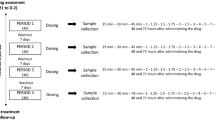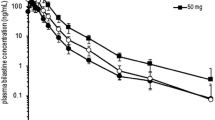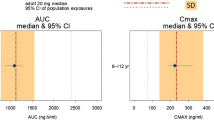Abstract
Mizolastine is a second generation antihistamine agent approved in Europe for the treatment of allergic rhinitis and skin conditions for which Sanofi∼Synthélabo is developing a pediatric solution. Our objective was to design the population pharmacokinetic (PK) study of mizolastine pediatric solution in children. A bioavailability study of this solution compared to the marketed tablet was performed in 18 young volunteers. These PK data were analyzed by nonlinear regression using a two-compartment open model with zero-order absorption. From the estimated parameters, we designed population PK studies in two groups of children: 6 to 12 years and 2 to 6 years, respectively. To compare several population designs and to derive the optimal ones, we used the determinant of the Fisher information matrix of the population characteristics using a first-order expansion of the model. We have evaluated a “reference” population design with 10 samples (from 0.25 to 36 hr after drug intake) per child in 6 children, which could not be implemented in practice for ethical reasons. We then derived optimal population designs with 1, 2, 3, 4, or 5 samples per child and a total of 60 samples. Finally, the designs that were implemented in the population PK study were “compromise” population designs with 60 samples; one defined for 20 children 6 to 12 years old , and one with 24 children 2 to 6 years. In the older group, the population design involved 8 children with a catheter from which 6 samples at time 0.25, 0.5, 0.75, 2, 3, and 6 hr after drug intake are collected, and 12 children with only one sample at time 8, 12, 24, or 36 hr. In the younger group, the population design involved 15 children with a catheter who are divided in three groups with four samples at different times from 0.25 to 6 hr after drug intake, and 12 children with only one sample at time 8, 12, 18, or 24 hr. The expected average increase of variances of these designs compared to the reference design were 1.6 and 1.8 for the older and younger group, respectively, which was decided to be acceptable. Better population designs would have involved three groups of children with five samples per child but could not be implemented in practice. The data of the PK study in children 6 to 12 years were available and were analyzed using NONMEM. A total of 53 concentrations were obtained in 18 children. The same two-compartment model with zero-order absorption was used. The interindividual variability in children was small. The estimated population parameters in children 6 to 12 years, were 0.28 L/kg for Vc/F, 0.10 L/hr per kg for CL/F, 0.53 hr−1 for λ1, 0.076 hr−1 for λ2 , and 0.49 hr for T abs . These values were close to the median values observed in young volunteers when standardized to 70 kg; notably, CL/F in L/hr per kg was similar, so that a dose of 0.15 mg/kg o.d. for mizolastine pediatric solution should give an equivalent area under the curve to a 10 mg o.d. tablet in adults.
Similar content being viewed by others
REFERENCES
F. Mesnil, C. Dubruc, F. Mentré, S. Huet, A. Mallet, and J. P. Thénot. Pharmacokinetic analysis of mizolastine in healthy young volunteers after single oral and intravenous doses: Noncompartmental approach and compartmental modeling. J. Pharmacokin. Biopharm. 25:125–147 (1997).
F. Mesnil, F. Mentré, C. Dubruc, J. P. Thénot, and A. Mallet. Population pharmacokinetic analysis of mizolastine and validation from sparse data on patients using the nonpara-metric maximum likelihood method. J. Pharmacokin. Biopharm. 26:133–161 (1998).
F. Mentré, A. Mallet, and D. Baccar. Optimal design in random-effects regression models. Biometrika 84:429–442 (1997).
F. Mentré, P. Burtin, Y. Merlé, J. van Bree, A. Mallet, and J. L. Steimer. Sparse-sampling optimal designs in pharmacokinetics and toxicokinetics. Drug Inform. J. 29:997–1019 (1995).
M. Tod, F. Mentré, Y. Merlé, and A. Mallet. Robust optimal design for the estimation of hyperparameters in population pharmacokinetics. J. Pharmacokin. Biopharm. 26:689–716 (1998).
C. Dubruc, F. Mentré, S. Chaufour, P. Scheinmann, I. Dab, J. L. Pinquier, and P. Rosenzweig. Population pharmacokinetics of an oral solution of mizolastine, a new anti-histamine, in children. Clin. Pharmacol. Ther. 67:96 (2000).
D. W. Marquardt. An algorithm for least squares estimation of nonlinear parameters. J. Soc. Ind. Appl. Math. 11: 431–441 (1963).
S. L. Beal and L. B. Sheiner. NONMEM Users Guides, Version 5, NONMEM Project Group, University of California at San Francisco, 1996.
M. Davidian and D. M. Giltinan. Nonlinear Models for Repeated Measurement Data, Chapman and Hall, London, 1995.
J. L. Steimer, A. Mallet, J. L. Golmard, and J. F. Boisvieux. Alternative approaches to estimation of population pharmacokinetic parameters with the nonlinear mixed effect model. Drug Metab. Rev. 15:265–292 (1984).
A. C. Atkinson and A. N. Donev. Optimum Experimental Design, Oxford University Press, Oxford, 1992.
H. P. Wynn. The sequential generation of D-optimum experimental designs. Ann. Math. Statist. 41:1655–1664 (1970).
M. F. Vest and R. Salzberg. Conjugation reactions in the newborn infant: The metabolism of para-aminobenzoic acid. Arch. Diseases in Childhood 40:97–105 (1965).
Food and Drug Administration. Regulations requiring manufacturers to assess the safety and effectiveness of new drugs and biological products in pediatric patients, 21 CFR Parts 201, 312, 314, and 601. In Federal Register, Part II Department of Health and Human Services, Vol. 63, No. 231, 1998, pp. 66632–66672.
S. Retout, S. Duffull and F. Mentré. Development and implementation of the population Fisher information matrix for the evaluation of population pharmacokinetic designs. Comput. Meth. Prog. Biomed. 65:141–151 (2001).
Rights and permissions
About this article
Cite this article
Mentré, F., Dubruc, C. & Thénot, JP. Population Pharmacokinetic Analysis and Optimization of the Experimental Design for Mizolastine Solution in Children. J Pharmacokinet Pharmacodyn 28, 299–319 (2001). https://doi.org/10.1023/A:1011583210549
Issue Date:
DOI: https://doi.org/10.1023/A:1011583210549




